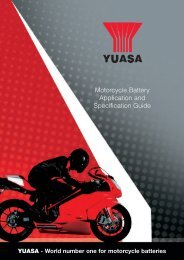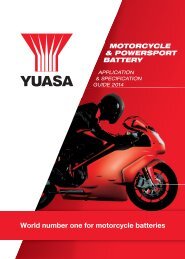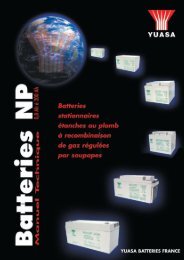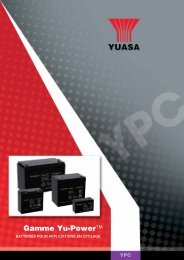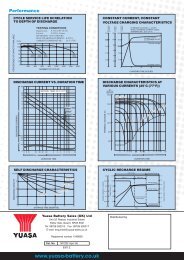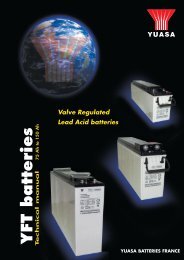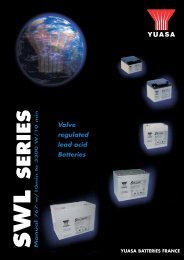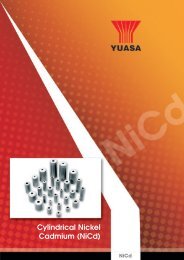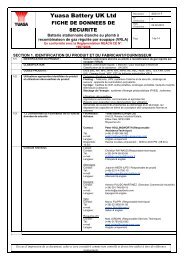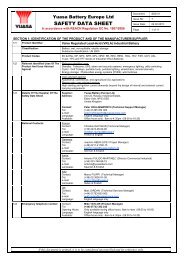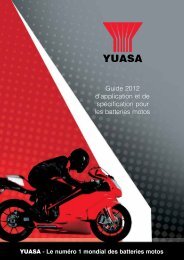to download CV, PSV, LCV, Agricultural & Plant Catalogue - Yuasa
to download CV, PSV, LCV, Agricultural & Plant Catalogue - Yuasa
to download CV, PSV, LCV, Agricultural & Plant Catalogue - Yuasa
- No tags were found...
Create successful ePaper yourself
Turn your PDF publications into a flip-book with our unique Google optimized e-Paper software.
Battery Characteristics & Fault Diagnosis<strong>Yuasa</strong> Lead Acid batteries are built <strong>to</strong> the highest standards.They are manufactured, in most cases <strong>to</strong> correspond with orexceed the vehicle manufacturer’s requirements andspecifications.Nevertheless, it should be clearly unders<strong>to</strong>od that:A wet (filled) lead acid battery is “a live” product. Whether it is ins<strong>to</strong>rage or in service, it has a finite life. All batteries once filled willslowly self discharge. The higher the s<strong>to</strong>rage temperature andhumidity of the s<strong>to</strong>rage area, the greater the rate of self discharge.To ensure the batteries are not allowed <strong>to</strong> discharge <strong>to</strong> the pointwhere they are damaged (sulphated) or so incapable of givingdesigned service life, regular checks of the recharge date labelon the back of the battery, and voltage checks of batteries withless than 4 month remaining should be made. It is important <strong>to</strong>ensure good turn around of s<strong>to</strong>ck, first in, first out, especiallywith slow running s<strong>to</strong>ck of low volume lines. Batteries with avoltage of 12.35V or below should be recharged immediately.Recharging must not be effected by means of a rapid chargerdue <strong>to</strong> the inefficiencies when attempting <strong>to</strong> recharge a partiallysulphated battery which leads <strong>to</strong> excessive gassing anddamage <strong>to</strong> the active material grid bonds within the battery,which are critical <strong>to</strong> ensure battery life. Ideally use a rechargerate as stated in “recommended recharge rate and period”according <strong>to</strong> battery type and catalogue instructions. At the endof discharge, all cells should be gassing freely. It is clearlyrecommended that batteries are left <strong>to</strong> stand for a minimum of3 hours after charging <strong>to</strong> ensure any gases trapped in the upperbattery casings are allowed <strong>to</strong> diffuse in<strong>to</strong> the atmosphere. If abattery has been recharged, the recharge date on the backlabel should be updated by 6 months after second rechargedate by physically notching the label. (Note a maximum of tworecharges are allowed prior <strong>to</strong> sale, and product should not besold a maximum of 9months after the expiry of firstrecommended recharge date).Battery ProblemsNon Manufacturing DefectsPhysical DamageIf the battery is s<strong>to</strong>red, handled or fitted incorrectly, if theconnec<strong>to</strong>rs leads are hammered on<strong>to</strong> terminals, leads are notcorrectly fastened, the battery will have damage <strong>to</strong> casing and/or terminals. This is not a manufacturing fault.* Note all batteries picked and dispatched from <strong>Yuasa</strong>’s UKwarehouse are pho<strong>to</strong>graphed prior <strong>to</strong> dispatch <strong>to</strong> ensure ourshipping quality targets are met.SulphationIf a battery is allowed <strong>to</strong> stand in a discharged state either on oroff a vehicle for a period of time, a chemical reaction takesplace which will permanently impair the performance and life ofthe battery, this process is called “sulphation”.Sulphation can be seen as a fine white/grey coating on thepositive plate and a non metallic luster on the negative plate. Inmost cases this signifies the battery as not serviceable.Attempts <strong>to</strong> recharge batteries left in a discharged state, evenat very low charge rates will lead <strong>to</strong> damage <strong>to</strong> the grid andactive material interfaces and also sulphate deposits can beformed within the separa<strong>to</strong>rs which produce dendritic shorts.The damage can occur in s<strong>to</strong>rage or if the battery is installed onthe vehicle (or equipment) that is not used for a period of time,for example trac<strong>to</strong>r, mo<strong>to</strong>rcycle, boat, airport vehicle even a caror truck that is s<strong>to</strong>red with the battery connected can stilldamage the battery. This is because there is a permanent drainon the battery from items such as the alarm, clock, lights, etcleft on which drag the battery down <strong>to</strong> its lowest possible stateof charge. The longer the period left, the greater the sulphationbuilds up on the plates.The sulphation hinders the efficiency of the electrochemicalreactions within the battery between the active material of theplates and the acid. This is not a manufacturing fault.Wear and TearAs the battery is cycled, i.e. charged and discharged, the activematerials within the battery plates are in motion in order <strong>to</strong>release the electricity s<strong>to</strong>red by the battery. Every time thebattery is charged and discharged a small amount of activematerial is permanently lost from the plates.As the ultimate battery life is determined by many fac<strong>to</strong>rs, suchas temperature, battery operating state of charge, duty cycle,etc it is impossible <strong>to</strong> stipulate a minimum/maximum lifeexpectancy in the field. This process of normal ageing will eventuallycause the battery <strong>to</strong> lose capacity and it will come <strong>to</strong> thepoint where the battery can no longer start the vehicle orequipment. Modern fuel injected cars start much more quickly,typically using a surface discharge off the battery plates, hencethe unexpected failure of the battery is more often than notseen when the battery is first put under stress, for example on acold morning, or after a weekend stand. This is not amanufacturing fault.It is always best <strong>to</strong> take the opportunity of free battery checksprior <strong>to</strong> the onset of cold weather or long airport parkingperiods.Deep CyclingAs above, every time a battery is charge and discharge cycleda small amount of material is lost. If a battery is subjected <strong>to</strong>deep discharging (greater than 35%) and rapid charging theprocess is accelerated. Additionally if the recharge does notrecover the discharge cycle in full, the battery will exhibit loss ofperformance and concentration of the acid can occur betweenplates which can lead <strong>to</strong> corrosion and loss of performance.Even after recharging, the voltage will be low (under 12.4V) butif the cells acid gravities are checked they will generally be evenacross the battery. This is not a manufacturing fault.OverchargingIf the alterna<strong>to</strong>r regula<strong>to</strong>r is not set properly, or alterna<strong>to</strong>rvoltage control circuit fails, then the battery can be subjected <strong>to</strong>an excessive charge.If left unchecked the battery will overheat and will start <strong>to</strong>evaporate the electrolyte. The overcharging will accelerate thebreak up of the active material and grids and the battery willlose performance. Examination of the battery will typically showlow acid level and usually a black coating on filler plugs and astrong smell. It is recommended that the alterna<strong>to</strong>r chargingvoltage is checked by a mechanic. This is not amanufacturing fault.False ClaimIn order <strong>to</strong> minimise fraudulent battery claims each <strong>Yuasa</strong>battery has its own individual unique number found on the backlabel of the battery. It is recommended that this number isBattery TestingYUASA - The world's leading battery manufacturer505




